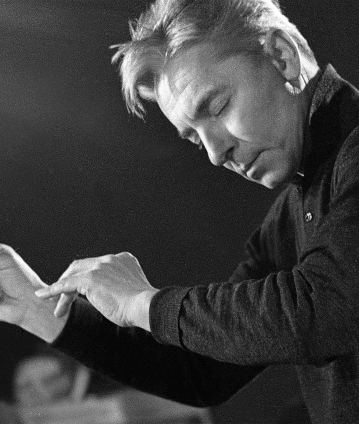Performance and conversation: Karajan conducts Dvořák’s Symphony No. 9

In Antonín Dvořák’s Symphony From the New World, Herbert von Karajan and the Berliner Philharmoniker were able to show the whole of their vast range of tonal colours. In this black and white documentary film from 1966, directed by Henri-Georges Clouzot, Karajan appears not only as the conductor but also discusses his personal view of Dvořák’s most popular work in interview.
In the winter of 1965–66 Herbert von Karajan made a series of documentary films with the distinguished French director Henri-Georges Clouzot (1907–1977). Using a combination of rehearsal sequences, interviews and specially filmed complete performances, Karajan hoped to reveal for the first time the inner workings of the very different worlds of rehearsal and performance. Shot in black and white, Clouzot’s preferred medium, the series was entitled Die Kunst des Dirigierens (The Art of Conducting).
For the film of Dvořák’s last symphony From the New World, Karajan chose to explore with the musicologist Denis Stevens how the work came into being, its folkloric aspects in particular. Happy to play the role of the enquiring pupil, Karajan also reveals himself to be formidably well informed both about the symphony and the wider cultural issues which surround it.
Karajan made his earliest forays into the Czech repertory in the late 1930s. He knew and revered the work of the great conductor Václav Talich and was strongly influenced by Arturo Toscanini who was a justly celebrated interpreter of the New World Symphony. Karajan first recorded the symphony with the Berliner Philharmoniker in March 1940. By the time of this 1966 film his reading was less episodic, more of a piece. It is also more exciting aurally. Under Karajan’s inspired tutelage, the Berlin Philharmoniker were by this time as much revered for their playing of Debussy, Ravel and Sibelius as they were for their playing of Brahms and Beethoven. Dvořák is often thought of as a Czech Brahms. In this electrifying 1966 account of the New World Symphony, Dvořák’s last symphony appears to look forward as much as it looks back.
© 1966 Unitel
Related interviews
Artists
Our recommendations
- Karajan conducts Beethoven’s Sixth Symphony
- Karajan conducts Beethoven’s Symphony No. 5
- Karajan conducts Brahms’s Symphonies Nos. 1–4
- Karajan conducts Beethoven, Weber, Rossini and Wagner
- Herbert von Karajan and Mstislav Rostropovich with Strauss’s “Don Quixote”
- Karajan conducts Beethoven’s “Missa solemnis” in Salzburg